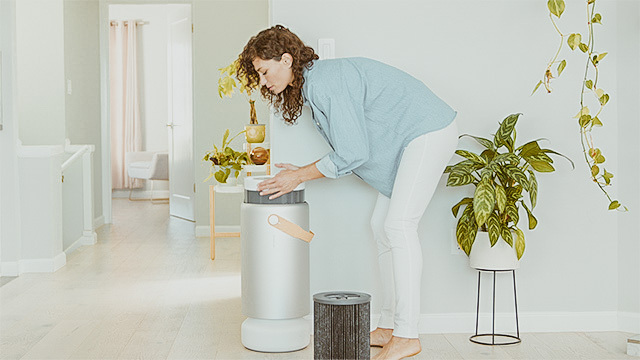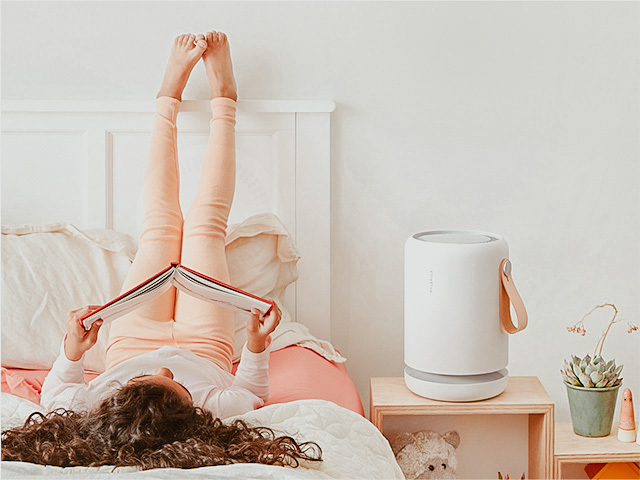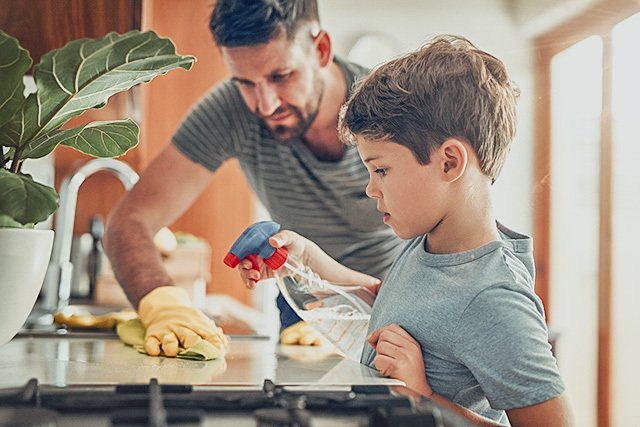As parents, we do everything we can to keep our families safe and healthy. We childproof our homes, make sure they eat well, and buy the best products for their overall well-being. But what about the air inside our homes?
While it’s easy to overlook, your indoor air quality can have a big impact on your kids’ health—just one more vital step in safeguarding their health!
We’ve broken down five surprising indoor allergies that could be affecting your family’s health and what you can do next to keep them protected.
5 Common Indoor Allergy Triggers You Might Not Know About

1. Dander
Despite common misconceptions, dander are tiny flecks of skin shed by both animals and people. Although you may think your cat or dog is a culprit, your child’s pet hamster or bird can also create dander. “Even your hairless cat can shed dander,” adds Gene Ehrbar, VP of Product at Molekule. And while hypoallergenic breeds exist, Ehrbar also warns that no animal is truly dander-free.
Dander often accumulates on your floors and furniture, and at times, it can become airborne and linger in the air, especially as you sweep or vacuum your house. Even if you don’t have pets, dander can make its way into your home on clothing or by visitors who have animals.
If you have any sensitive kiddos in your house, keep an eye out for sneezing, coughing, a runny nose, itchy, red, or watery eyes, or if they rub their nose a lot. For children with asthma, a dander allergy can also cause difficulty breathing, chest tightness, or a whistling or wheezing sound when they breathe out.
2. Volatile organic compounds
Volatile organic compounds (VOCs) are chemicals that can be released into the air from household products, such as paints, cleaners, and air fresheners. They can cause short-term and long-term health effects, from headaches and nausea to irritation of the eyes, nose, and throat.
Ehrbar also urges parents to take caution with another household item you might not be aware of that releases VOCs: your gas stove. “You may have read in the news recently that gas stoves and the overall effects of cooking have an impact on indoor air quality,” says Ehrbar. “Inadequate ventilation can lead to unhealthy levels of nitrogen oxide, carbon monoxide, and formaldehyde.”
And a recent Harvard study can confirm. Their recent study identified 21 VOCs alone from gas stoves that increase both children’s and adult’s risk for asthma, cancer, and other illnesses.

3. Dust mites
Dust mites are microscopic pests that live in the dust throughout our homes, as well as in the objects we use or come in contact with daily—we’re talking mattresses, pillows, bedding, upholstered furniture, carpets, and even your kids’ stuffed animals. They thrive in warm, humid environments, and feed on dead skin flakes that we and our pets shed (yep, you read that right!).
Unfortunately, this common indoor allergen can trigger allergic reactions and asthma symptoms in sensitive individuals, especially children. As kids typically spend most of their time playing indoors and on the ground, their developing lungs are more susceptible to ingesting dust and dirt.
“They inhale more air more rapidly in proportion to their size than adults do, which increases their exposure to air pollutants,” says Ehrbar. “They’re more likely to breathe through their mouth, meaning that pollutants bypass the body’s nasal filtration.”
4. Cockroach allergens
We hate to say it, but cockroaches are adaptable creatures that can survive in a wide range of environments. Sure, they commonly prefer more warm and humid environments, but they can survive just about anywhere there’s abundant food and shelter.
While you may not even have cockroaches in your home, there can still be cockroach allergens (a substance from cockroach saliva and droppings) lurking in your home. According to the American Lung Association, one in five homes that never had a cockroach problem still contain a significant amount of cockroach allergen in dust and fabrics.
These allergens, as you likely already guessed, are usually found in kitchens, bathrooms, and other areas of the home where food is stored or prepared. They can worsen kids’ asthma symptoms and trigger asthma attacks, so be sure to keep your spaces clean and free of food debris.

5. Mold
Mold is a type of fungus that loves damp, humid environments. It spreads by releasing tiny spores into the air that can grow on your walls, ceilings, floors, and on furniture or carpet if they become damp. And it doesn’t take long for mold to take over; once a spore attaches to an item, mold can grow within 24 to 48 hours, and start to colonize anywhere from three to 12 days.
If you currently have any areas of your house with moisture issues, like the bathroom, kitchen, basement, and attic, it’s best to address it as soon as possible, as mold typically thrives in these spaces. Although some may be able to coexist with certain types of mold, kids’ respiratory systems are still developing.
This makes them more vulnerable to the effects of mold exposure, which can look like sneezing, a stuffy nose, itchy skin and rashes, recurring colds, or respiratory issues, such as coughing and chest tightness.
How to Control Indoor Allergies in Your Home
Reducing indoor allergies in your home can help create a healthier environment for your family. Here are some tips to help you minimize these five common allergens:

1. Upgrade your indoor air quality with Molekule’s air purifiers
Add an air purifier to rooms where your family spends the most time to ensure they’re breathing the cleanest air possible. Molekule’s Air Pro and Mini+ use a patented technology that goes beyond conventional filters to destroy allergens, pet dander, mold, bacteria, viruses, and odors.
The Air Pro is perfect for larger living spaces (like living rooms and family rooms), while the Mini+ is ideal for smaller areas like nurseries, playrooms, and bedrooms. Both air purifiers feature sensors that automatically adjust to air particle and chemical levels, ensuring that your air stays clean and fresh without any manual intervention. They’re also app-enabled and whisper-quiet, so you can control it from your smartphone and enjoy a peaceful environment.
2. Clean your home regularly
Although it now seems almost inevitable that you’ll come into contact with dust mites—four in five homes in the U.S. have dust mite allergens in at least one bed!—you can help reduce them by washing your bedding regularly in hot water and using allergen-proof covers on mattresses and pillows. Be sure to also vacuum carpets and upholstery regularly to cut down on dust mites and dander, and remove shoes and outerwear before entering the home.

3. Remember: No crumbs left behind
Worried about cockroach allergens? Store food in airtight containers, and seal cracks and crevices where cockroaches can enter the home. Look to cockroach baits or traps, and keep, Molekule’s air purifier close by to further eliminate allergens.
4. Don’t forget pets need upkeep, too
Bathe and groom your pets regularly to reduce shedding, and wash their bedding and toys frequently. Try to designate pet-free zones in your home, especially in bedrooms, to help eliminate areas with pet dander.

5. Opt for natural cleaning products
Choose household products labeled as “low VOC” or “VOC-free,” and when using products like paints, cleaners, and air fresheners, do so in well-ventilated areas. Increase ventilation in your home by opening windows and using fans, and consider using natural alternatives to chemical-based products.
Improve your indoor air quality this spring by shopping for the Air Pro and Mini+ purifiers to help your family breathe easier!













